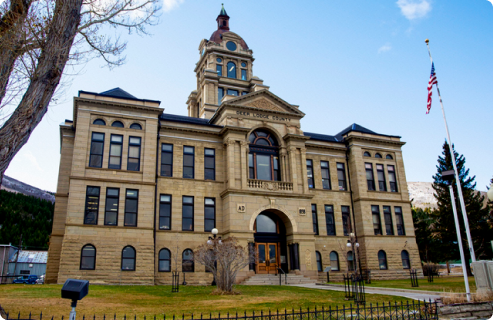
- $8.5 Billion Recovered
- Serves Clients Nationwide
- Rated #1 by U.S. News & World Report for 2022
Montana residents faced an asbestos exposure disaster in Libby, which caused thousands to become ill. People have also been exposed to asbestos at other commercial and industrial job sites in the state. An experienced mesothelioma attorney can help people in Montana get the compensation they need.

If you live in Montana and received a mesothelioma diagnosis, you need the help of experienced legal professionals who understand the process of filing compensation claims in local courts for asbestos exposure. Your asbestos attorney will manage your mesothelioma lawsuit, limiting stress on you and your family.
Asbestos exposure was common in Montana. Approximately 1 in 10 people living in Libby, Montana, have an asbestos-related illness, according to the Center for Asbestos Related Disease. Montana’s Supreme Court created a specialized Asbestos Claims Court to manage the large volume of Libby-related asbestos lawsuits. From 2018 to 2022, the mesothelioma incidence rate was 0.90 per 100,000 people, with 64 new mesothelioma cases reported.
National firms that specialize in mesothelioma lawsuits are a good choice because they have experience facing large corporations and winning. Top asbestos firms support patients and have the resources to see cases through.


Montana has reached several notable asbestos verdicts and settlements, totaling millions of dollars in mesothelioma compensation. Many are related to the asbestos exposure disaster in Libby. Along with lawsuits and settlements, skilled mesothelioma lawyers in Montana have recovered six-figure payouts from asbestos trust funds.
Notable Montana Verdicts, Settlements or Trust Fund Payouts
Mesothelioma settlements often range from $1 million to $2 million. Trial verdicts typically average higher, sometimes reaching $20 million or more, according to the latest data from Mealey’s. Every case is unique, and compensation depends on your specific circumstances.
An asbestos lawyer can help you file a personal injury lawsuit for mesothelioma or apply for relevant asbestos trust fund claims. Experienced mesothelioma firms can also help surviving family members file a wrongful death lawsuit in Montana.
Steps to a Mesothelioma Claim
Filing a claim in another state may also be an option if your asbestos exposure happened outside of Montana or involved contaminated products from manufacturers headquartered elsewhere. Your mesothelioma lawyer can guide you through the process.

Over $30 billion has been set aside to support those diagnosed with mesothelioma. We’ll help you explore your options and introduce you to the nation’s leading mesothelioma law firms.
Get Help NowMost of Montana’s asbestos exposure cases can be traced to the former vermiculite mines near Libby, but mining isn’t the only industry at higher risk of exposure. Many commercial and industrial laborers in the state were exposed to asbestos products at work, especially in insulation products and heat-resistant building materials.
Sites in Montana Known for Asbestos Exposure
Buildings constructed in Montana before the 1980s, including schools, homes and government buildings, likely contain asbestos. This legacy asbestos can pose a danger if the material is damaged or deteriorates. The harmful fibers can become airborne when disturbed.
The W.R. Grace & Company vermiculite mine in Libby is infamous for the enormous emotional and financial losses it has caused families, not just in Montana, but throughout the U.S. According to EPA estimates and court records, the Libby vermiculite operation released around 5,000 pounds of asbestos into the air every day until the mine closed in 1990. The vermiculite was contaminated with hazardous tremolite, a type of asbestos.
Evidence suggests W.R. Grace knew about the dangers to company workers and town residents as of at least 1960, but hid the truth and pressured local doctors. In 2002, the EPA added Libby to its Superfund National Priorities List, eventually removing more than 3 million cubic feet of contaminated soil from over 2,500 local businesses and homes.
Montana workers have been exposed to asbestos at power plants, refineries, factories and construction sites. Exposure to asbestos-containing materials occurred across the state. Long-term exposure, either occupational or from living near a contaminated site, is responsible for many cases of mesothelioma.
Higher-Risk Jobs in Montana
Asbestos contamination in Libby has resulted in a history of secondhand asbestos exposure lawsuits. Secondary exposure happens when someone who works with asbestos inadvertently brings hazardous fibers home on their clothing, hair or skin. Secondary exposure is just as dangerous as primary exposure, and Montana courts have recognized the legality of these personal injury or wrongful death claims.
Montana laws are generally favorable to people who have mesothelioma and asbestos-related illnesses, as multimillion-dollar state verdicts show. Your attorney must still show proof that links your asbestos exposure to a specific site or products.
Montana Legislative Changes
Recent business-backed legislation would add new disclosure and evidentiary requirements in asbestos cases. Critics argue that these changes are intended to delay and complicate claims. A mesothelioma law firm with resources and extensive courtroom experience taking on big businesses can help you improve your chances of a successful outcome for your case.
Recommended ReadingStay up-to-date on treatment, research, clinical trials, doctors and survivors
The information on this website is proprietary and protected. It is not a substitute for professional medical advice, diagnosis or treatment. Any unauthorized or illegal use, copying or dissemination will be prosecuted. Please read our privacy policy and terms of service for more information about our website.
This website and its content may be deemed attorney advertising. Prior results do not predict a similar outcome.
The Mesothelioma Center’s claim as the most trusted resource is based on our more than 150 5-star Google and BBB reviews. Our organization also helps more than half of all mesothelioma patients annually diagnosed.
Your web browser is no longer supported by Microsoft. Update your browser for more security, speed and compatibility.
If you are looking for mesothelioma support, please contact our Patient Advocates at (855) 404-4592
The Mesothelioma Center at Asbestos.com has provided patients and their loved ones the most updated and reliable information on mesothelioma and asbestos exposure since 2006.
Our team of Patient Advocates includes a medical doctor, a registered nurse, health services administrators, veterans, VA-accredited Claims Agents, an oncology patient navigator and hospice care expert. Their combined expertise means we help any mesothelioma patient or loved one through every step of their cancer journey.
More than 30 contributors, including mesothelioma doctors, survivors, health care professionals and other experts, have peer-reviewed our website and written unique research-driven articles to ensure you get the highest-quality medical and health information.
My family has only the highest compliment for the assistance and support that we received from The Mesothelioma Center. This is a staff of compassionate and knowledgeable individuals who respect what your family is experiencing and who go the extra mile to make an unfortunate diagnosis less stressful. Information and assistance were provided by The Mesothelioma Center at no cost to our family.LashawnMesothelioma patient’s daughter


Lahav, J. (2025, November 25). Montana Mesothelioma Lawyers. Asbestos.com. Retrieved December 14, 2025, from https://www.asbestos.com/mesothelioma-lawyer/montana/
Lahav, Joe. "Montana Mesothelioma Lawyers." Asbestos.com, 25 Nov 2025, https://www.asbestos.com/mesothelioma-lawyer/montana/.
Lahav, Joe. "Montana Mesothelioma Lawyers." Asbestos.com. Last modified November 25, 2025. https://www.asbestos.com/mesothelioma-lawyer/montana/.
A mesothelioma lawyer who specializes in asbestos litigation reviewed the content on this page to ensure it is legally accurate.

William A. Davis is an attorney specializing in complex commercial litigation, with an emphasis in health care disputes, at a firm he founded in Washington, D.C. He also serves as senior counsel at The Peterson Firm.
Our fact-checking process begins with a thorough review of all sources to ensure they are high quality. Then we cross-check the facts with original medical or scientific reports published by those sources, or we validate the facts with reputable news organizations, medical and scientific experts and other health experts. Each page includes all sources for full transparency.
Please read our editorial guidelines to learn more about our content creation and review process.
